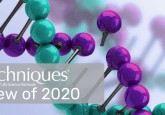From the journal: Francesca’s pick of Volume 69 Issues 1—3

Editor-in-Chief Francesca Lake’s picks of her top five articles from Volume 69 Issues 1—3 of BioTechniques.
BioTechniques has two volumes per year, and this July saw the first issue of Volume 69. The past 3 months has seen – in addition to a continued focus on COVID-19 – our online focus turn toward Big data and neuroscience. For the latter, I hope you’ll join us for our mental health awareness Twitter chat, which is taking place on Friday, October 9.
In other news, our podcast series has continued, with our latest episode discussing helicopter research and the challenges faced by researchers in Africa. We have also recently launched our Peek Behind the Paper series, which offers authors (not just our own!) the ability to offer more insight into their newly developed methodologies and garner more attention. You can learn more about the benefits of this feature here.
In terms of our peer-reviewed content, for those of you who don’t have time to read our full (and free) Digital Edition, I’ve once again selected my five highlights from this edition. If you missed the last edition, you can find my highlights here.

From the journal: Francesca’s picks of Volume 68 Issues 4—6 – Find out what Francesca’s picks of the top five articles from Volume 68 Issues 4—6 of BioTechniques were by catching up now!
Vaishali Verma, Amita Gupta & Vijay K Chaudhary
Anything that makes a method easier is always important, and this Benchmark is no exception. Here, the authors provide a method update for emulsion PCR (ePCR) that removes the tedious steps required to separate DNA from the oil and detergents used in preparation – a step that also requires hazardous solvents. Handily, they have made their 8-step ‘Quick ePCR extraction protocol’ available on protocols.io.
Read the full article and access the protocol here.
Bijun Cheng & Tianjiao Li
There’s a few COVID-19-relevant articles in this edition that all deserve a mention; however, this one is proving the most popular thus far, with over 2500 full-text readers at the time of writing. Here, the authors used molecular docking to assess the binding stability of remdesivir, ritonavir and chloroquine with Mpro – the main protease of SARS-CoV-2. Their resultant in silico analysis highlighted alliin as a good candidate for further investigation.
Read the full article here.
Alexandre Zougman, John P Wilson & Rosamonde E Banks
Heretofore, proteomics requiring serum depletion has been costly and complex – serum is itself complex with a number of abundant proteins. This Benchmark here hopes to change things – the method allows for fractionation-capture and in situ digestion of serum proteins ready for bottom-up proteomics. The team intends to make their protein-trapping units commercially available to improve ease-of-use and reproducibility.
Read the full article here.
Yinhua Zhang, Guoping Ren, Jackson Buss, Andrew J Barry, Gregory C Patton & Nathan A Tanner
Loop-mediated isothermal amplification (LAMP) has received plenty of coverage of late as a potential to improve diagnosis of SARS-CoV-2 infection. However, the sensitivity of colorimetric LAMP has been demonstrated to be lower than RT-qPCR. Here, the authors sought to improve its performance, using guanidine hydrochloride and combined primer sets to improve speed and give a five- to ten-fold increase in sensitivity.
Read the full article here.
Nobuyuki Tanaka, Ryoji Sekine, Shun-ichi Funano, Asako Sato, Núria Taberner Carretero , Miki Ebisuya & Yo Tanaka
Good quantitative measurements can be difficult to achieve during cell microscopy, for example, due to cell migration out of the field of view. Here, the authors created and demonstrated the use of an MPC polymer film for cell patterning. The technique was rapid and successfully maintained and confined cells for 168 hours. While microstructures such as this are becoming popular for cell imaging, the authors note this particular technique is accessible and would lend itself well to mass production. The use of MPC polymer would also make it useful for bacterial patterning. The authors have provided a video abstract for anyone interested in watching the technique.
Read the full article and watch the video abstract here.





